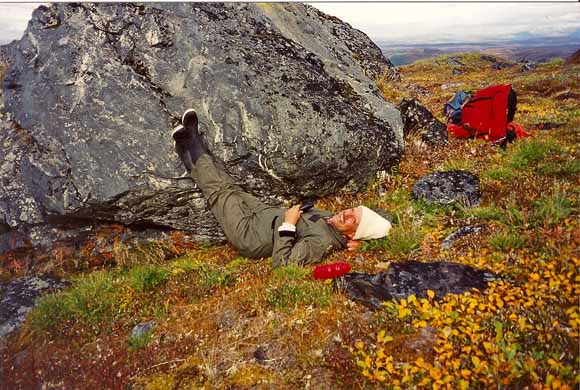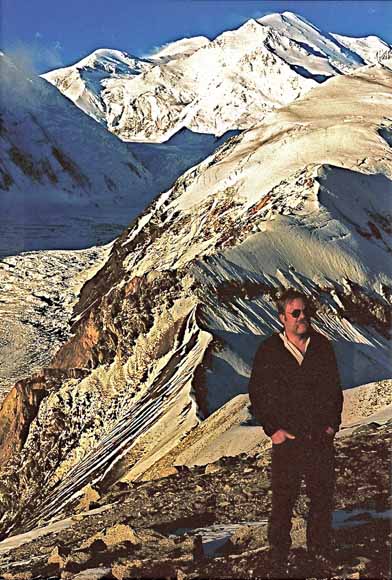
By Béla Csejtey, Jr.1, Arthur B. Ford2, Warren E. Yeend2, Phil F. Brease3, and Chester T. Wrucke2
1 Deceased; Denali Associates
2 Denali Associates
3 Deceased; National Park Service, Denali National Park, AK 99755

“A new scientific truth does not triumph by convincing
its opponents and making them see the light, but
rather because its opponents eventually die, and a
new generation grows up that is familiar with it.”
—Max Planck
This web report presents the authors’ interpretation of the Denali fault as a culmination of their 32 years of geologic fieldwork in central Alaska between 1972 and 2004. The authors’ investigations along a 240 km segment of the fault lead them to a very different interpretation of the structure and tectonic setting of this feature then what is commonly accepted by the majority of the geologic community. It needs to be pointed out that the commonly accepted concept of the Denali fault as being a 1,900-km-long and sharply-curving dextral strike-slip feature is only based on sufficient field investigations of the eastern two-thirds of this structure, and from near west of Paxson it was only extrapolated to be a strike-slip feature. To the authors knowledge, there have been no field investigations other than theirs on the western segments of the fault on the detailed scale required, certainly not on the segment in Denali National Park and Preserve. The authors’ investigations included the critical segment of the fault where a change from strike-slip to dominantly dip-slip movement takes place. Thus, the authors were able to construe, in their opinion, a more plausible concept of this fault than previously available.
Owing to strong resistance by a large segment of the geologic community to the authors’ interpretation of the Denali fault, and hence difficulty in peer-review publishing through established journals, the authors decided to make their interpretation available to interested researchers in a timely manner by Internet publishing. To this end, the authors hope that lack of extensive editing and stylistic revisions will not affect the clarity and understanding of the essential theme of the paper.
A different version of this paper probably will be available in the proceedings volume of the meetings called Symposium 2010 of the Geological Society of Nevada.
In a following section of this website, the authors display a few of their previous publications with supporting evidence for their interpretation of the Denali fault. These reports also show how their ideas progressed as more and more field evidence was obtained.
During the authors’ 32 years of field work in central Alaska, many people extended to them material and logistical help and support. They express their heartfelt thanks to all of them, but to name them all would be impossible. However, special mention needs to be made of the National Park Service and personnel at Denali National Park, and to Mrs. Ruth Ann Wrucke, Mrs. Barbara Brease, and Mr. Bob Wrucke. Park Service personnel at Denali National Park and Preserve were most helpful in all matters related to working in the Park, provided invaluable helicopter lifts, logistical support, and always encouraged us in our work. Mrs. Ruth Ann Wrucke had volunteered to be our camp cook for two field seasons, always and cheerfully preparing outstanding meals, fit for a gourmet, under difficult field conditions. Mrs. Barbara Brease and her family always welcomed us into their home when in the Denali Park area going to and from the field, provided much appreciated hospitality, and helped with all matters of logistical preparations. Mr. Bob Wrucke volunteered for one field season to be our field assistant, driver, and general helper in the field and camp. Words are inadequate to express the authors’ appreciation to them.
It is with great sorrow we report the untimely death of our coauthor and respected coworker, true friend and supporter Phil Brease, who passed away during the final preparations for putting this report on the Internet. He will be sorely missed. Our heartfelt condolences go out to his family.
Finally, the authors’ most sincere thanks to Michael Diggles for all his help publishing this paper on the Internet.

Intrusive granite contact at Gunsight Pass—geologists Art Ford, Chet Wrucke, and Béla Csejtey in foreground

Warren Yeend taking a rest while mapping surficial deposits in Denali National Park
To view PDF papers on this Web site, you will need Adobe Reader.

The Denali Fault System and the Neotectonic Evolution of Central Alaska by Béla Csejtey, Jr., Arthur B. Ford, Warren E. Yeend, Phil F. Brease, and Chester T. Wrucke, 2010 (75.3 MB).
Remarks about the above neotectonics manuscript by Helen Foster, 2010 (29 kB).
Denali Fault Geologic Relations at Gunsight Pass, Denali National Park, Alaska by Arthur B. Ford, Béla Csejtey, Jr., and Chester T. Wrucke, 2003 (GSA Abstracts with Programs, v. 35, n. 6, p. 561; 29 kB).
Discrepancies Between Geologic Evidence and Rotational Models—Talkeetna Mountains and Adjacent Areas of South-Central Alaska by Béla Csejtey, Jr., 1990 (USGS Bulletin 1999, p. 71–80; 4.7 MB).
Tectonic Implications of a Late Paleozoic Volcanic Arc in the Talkeetna Mountains, South-Central Alaska by Béla Csejtey, Jr., 1976 (Geology, Jan. 1976, p. 49–52; 2.1 MB).

Phil Brease above intrusive granite contact at Gunsight Pass—Mt. McKinley in background
Suggested citation and version history
For questions about these papers, contact Art Ford
The URL of this page is http://www.diggles.com/denalifault/
Date created: October 27, 2010
Last modified: June 7, 2012